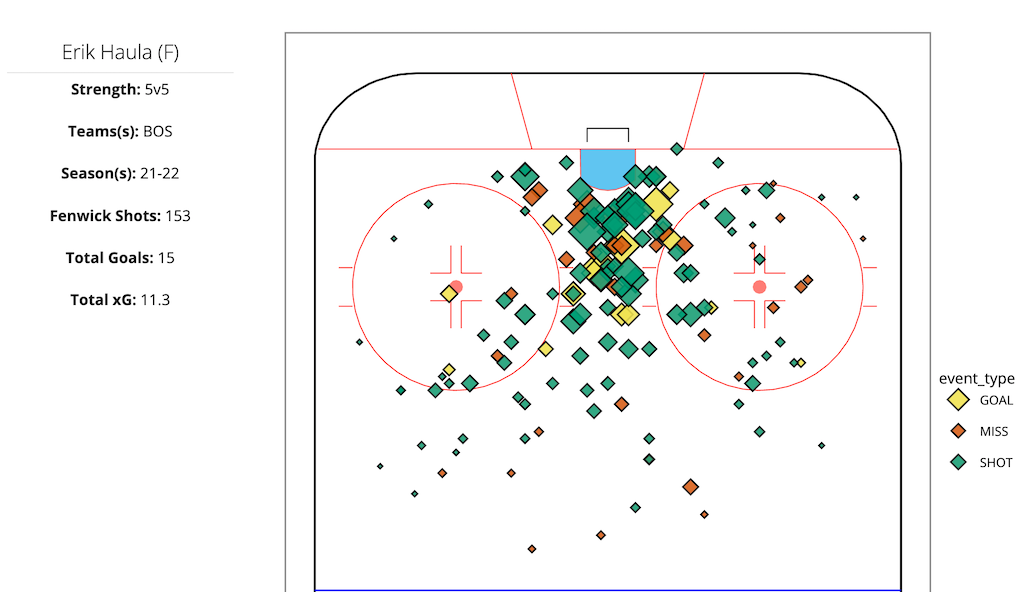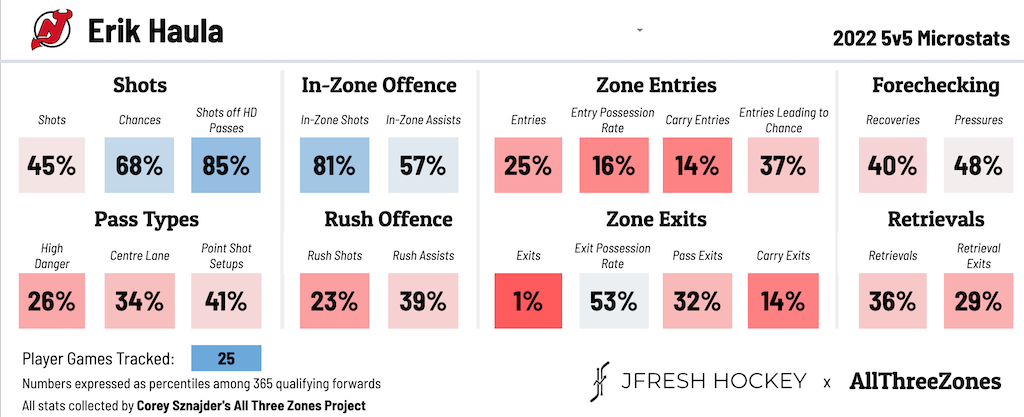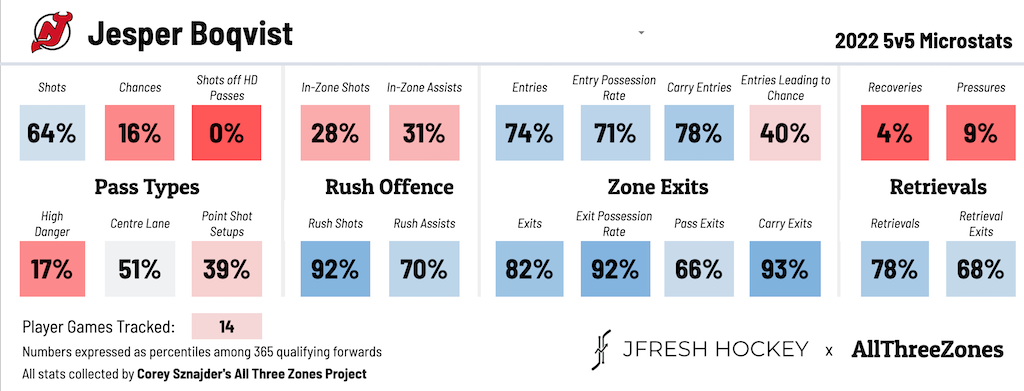Lost in the signing of Ondrej Palát and acquisition of John Marino was the New Jersey Devils trading for Erik Haula ahead of the start of free agency on July 13. With the team rumored to be looking to trade Pavel Zacha, they sent him to the Boston Bruins for Haula, who had 18 goals and 44 points in 78 games.
It’s clear that the Devils wanted some more veteran experience in their lineup for the 2022-23 season. Haula, who’s 31 years old, has played on five different teams over the last four years, but he did appear in the Stanley Cup as a member of the Vegas Golden Knights in 2018. Aside from his veteran experience, Haula does have things to offer on the ice and should give the Devils a bit of a different look up front from last season’s roster.
What Devils Get in Trading Haula for Zacha
Though Haula hasn’t come close to matching the 29 goals he totaled with the Golden Knights in 2017-18, he’s still been a steady middle-six contributor. Over the last three seasons, he’s averaged 18 goals and 41 points per 82 games, which is on par with his production from last season. That’s the kind of scoring you’d hope for from someone who’s likely heading for a third-line role in New Jersey.
While he may not be an elite five-on-five scorer, Haula has averaged 1.81 points per 60 minutes since 2019-20. That places him ahead of Tyler Toffoli, David Perron and Nino Niederreiter, to name a few. It’s quite a bit ahead of Zacha (1.51 points/60), so the Devils should get a five-on-five scoring upgrade with Haula in their middle-six.

When it comes to his on-ice shot metrics, Haula has averaged a Corsi for percentage (CF%) of 50.18 percent and expected goals percentage (xG%) of 49.24 percent over the last three seasons. However, he had a 52.07 CF% and 55.52 xG% in 2021-22 with the Bruins. Some of that is likely part of playing in the Bruins’ system, plus having David Pastrnak and Taylor Hall as his most common linemates. Linemates of that quality certainly help, but it also shows Haula can play higher up the lineup with a team’s more skilled players if he has to.
But even if he’s not playing on a line with players of Hall and Pastrnak’s caliber, what should make Haula a scoring upgrade for the Devils is his ability to shoot the puck from high-danger areas and convert on them. When looking at his shot chart from this past season, most of his shots came from the slot and around the crease, and so did most of his goals:

Compared to Zacha, their shot charts for 2021-22 are relatively similar; Haula had an xG of 11.5, while Zacha had an xG of 11.3. The difference is that Haula scored 15 goals while Zacha had nine. He’s a bit of a better shooter and should be able to capitalize on chances more often than Zacha did in his time in New Jersey. The question is whether he’s better off at center or on the wing, two positions he’s played before.
Does Haula Benefit More at Wing or Center?
Haula primarily played center for the Bruins, but he’s played plenty of left wing in the past. He’s won 54.3 percent of the 2,000 faceoffs he’s taken over the last three seasons, something he’ll be able to help improve for a Devils team that struggles in the dot. With that said, there’s much more that goes into playing center than taking draws.
Related: Devils’ Remaining Options for Scoring Help
When looking at Haula’s microstats, there are a few things he does quite well. He gets chances off at a good clip, particularly shots off high-danger passes. As we saw above, he converts on those chances too. Even though he’s not a great playmaker, he did have success with in-zone assists this past season. But if I had to guess, that had plenty to do with his most common linemates being Hall and Pastrnak.
Haula being able to generate offense in the offensive zone is a plus, but what about being able to gain the offensive zone? When it comes to zone entries, he struggles quite a bit. He ranks in the 16th percentile in entry possession rate and the 14th percentile in carry entries. It’s not much better when it comes to zone exits, though he ranks in the 53rd percentile in exit possession rate:

The biggest takeaway from Haula’s microstats is that he will need linemates who can transition the puck out of the defensive zone to start the rush. That’s likely why he had success in Boston with the Bruins; Hall is still one of the best transition wingers in the league, and Pastrnak is no slouch either. When you have wingers like Hall and Pastrnak who can transition the puck, it makes your job easier as a center.
But with the Devils, it’s unlikely Haula will have linemates of Hall and Pastrnak’s caliber if he’s in a third-line role. However, there are still some options that could make life easier for him when it comes to transitioning the puck. Tomáš Tatar didn’t have the best first season in New Jersey, but he was still quite effective in transition and creating off the rush. Jesper Boqvist had the best stretch of his career from January on and was one of the Devils’ best puck carriers last season:

If the Devils’ third line consists of Tatar, Boqvist and Haula, there’s probably a pretty strong case for Boqvist to be its center. Haula can still take draws since he excels at it, but it probably makes more sense to have Boqvist operate as the line’s main puck-carrier since he’s shown more of an ability to do so efficiently than Haula.
That’d probably also come to Haula’s benefit. Since his strength is his shooting and making things happen in the offensive zone, having Boqvist, who showed signs of being able to facilitate play as a center, will probably help Haula find the back of the net more often. He’s probably a better fit on the wing, especially for a Devils team that likes to play off the rush. But the fact he can play both positions and has had success at each gives the team a bit of versatility that’s always good to have.
More Depth Can Never Hurt
The Devils’ acquisition of Haula wasn’t anything earth-shattering, but he should help improve their depth scoring. He’s a more efficient five-on-five scorer than Zacha and can convert on his scoring chances more often. At 31 years old, he adds some veteran experience and is another forward who’s played in a Stanley Cup, though not to the extent of Palát. With one year left on his contract at $2.375 million, he checks off a need for next season. And if all goes well, he should make the Devils a deeper team in 2022-23.
* * *
Advanced stats from Natural Stat Trick
